Opus
NEBOJŠA SAVOVIĆ NES, SCULPTOR, WITH HIS TEAM, CARVING ORNAMENTS IN MARBLE OF THE ST. SAVA TEMPLE FOR ELEVEN YEARS
Filigree Embroidery in Stone
It is not a task for only one generation, let alone one human being. It’s not a matter of speed, but service, memory of the future. It is similar to an alchemical process and road of metamorphosis. A bridge connecting generations. This artist from Gornji Milanovac and his associates (Bojana Joksimović, Ivan Jeremić, Milorad Panić) continue what Nestorović, Deroko, Grassi began, and some new artists will continue the work of the present ones. It is true: we are building the temple, the temple is building us
By: Miloš Lazić
Photo: Željko Sinobad
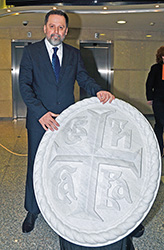 It was my first and certainly last chance to stand before the capital of the first pillar in the southern narthex of the Temple of St. Sava and touch it. The event was preceded by a breakneck climb up the metal ladder, under the care and supervision of Nebojša Savović Nes, famous Serbian sculptor, who has been carving the stone ornaments of the magnificent Orthodox temple for eleven years.
It was my first and certainly last chance to stand before the capital of the first pillar in the southern narthex of the Temple of St. Sava and touch it. The event was preceded by a breakneck climb up the metal ladder, under the care and supervision of Nebojša Savović Nes, famous Serbian sculptor, who has been carving the stone ornaments of the magnificent Orthodox temple for eleven years.
– This is my office – he laughed and spread his arms, as if wanting to embrace the narrow platform safely constructed on a scaffold around the top of the pillar, the one supporting the choir loft.
Nes’ ”office” has a non-transparent plastic foil around it. I am thankful to His Excellence the Employer for it, because the abyss and dizziness would distract my attention and reduce my pleasure.
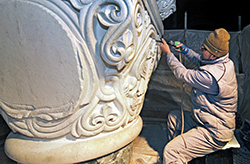 However, the first real surprise was discovering that he does not use chisel and hammer in his work, but a special ”tool” looking like an electric drill, supplied with energy from a compressor through a network of reinforced hoses.
However, the first real surprise was discovering that he does not use chisel and hammer in his work, but a special ”tool” looking like an electric drill, supplied with energy from a compressor through a network of reinforced hoses.
– Pino Grassi, contemporary of Nestorović and Deroko, who began the decoration, had to do it that way, with chisel and hammer. We are supported by technology – explained Nes. – That is why today we work at least three times faster than him. Here, what I’m doing takes around four working weeks or a month. When you add the work on the abacus (the part above the capital), it takes between six and eight weeks, depending on the motifs. Here we have birds, the next one has griffons, then dragons… Perha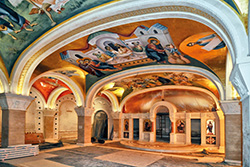 ps it could be faster, but these are so-called high reliefs, plenty of material has to be taken off. Giuseppe Grassi worked much slower, but he set a value and aesthetics role-model: we cannot go below it. I must mention a strange inconsistency: the works on the temple were begun by Giuseppe Pino Grassi, his students and my professors Miodrag Živković and Ajdin Puteš were skipped, and it continued with me, their student. I hope we will not skip any more generations.
ps it could be faster, but these are so-called high reliefs, plenty of material has to be taken off. Giuseppe Grassi worked much slower, but he set a value and aesthetics role-model: we cannot go below it. I must mention a strange inconsistency: the works on the temple were begun by Giuseppe Pino Grassi, his students and my professors Miodrag Živković and Ajdin Puteš were skipped, and it continued with me, their student. I hope we will not skip any more generations.
He laughed cheerfully when I, after turning on the abacus sitting in every human head behind the frontal bone, multiplied weeks and pillars and asked: what has he been doing for eleven years?
– I didn’t explain it correctly – he replied, almost apologizing. – When I mentioned working weeks, I 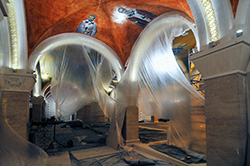 meant one side of the capital, one out of four. That means that there is at least sixteen weeks of work for the entire capital. And the pillars are numerous. Here: four for each of the three narthexes, another four at the western entrance, four in the altar… And it’s not only the pillars! If I were working alone, I don’t know how far I’d get. Luckily, I have my associates, three young sculptors, so I should mention them too: Bojana Joksimović, Ivan Jeremić and Milorad Panić. We have been working together for the past three or four years. Before that, during the works on the galleries and reliefs on biphoras, there were more people, including artisan stonecutters, who processed simpler forms.
meant one side of the capital, one out of four. That means that there is at least sixteen weeks of work for the entire capital. And the pillars are numerous. Here: four for each of the three narthexes, another four at the western entrance, four in the altar… And it’s not only the pillars! If I were working alone, I don’t know how far I’d get. Luckily, I have my associates, three young sculptors, so I should mention them too: Bojana Joksimović, Ivan Jeremić and Milorad Panić. We have been working together for the past three or four years. Before that, during the works on the galleries and reliefs on biphoras, there were more people, including artisan stonecutters, who processed simpler forms.
The speed of the works, he said, is influenced by the fact that today the rough processing is done by machines.
– The machines are performing the boring part of the job and we do the handicraft, the ”filigree embroidery” in stone.
ABOUT NUMBER AND MEASURE
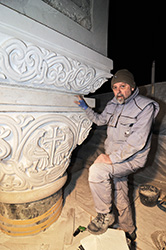 Everything he does is according to the designs of academician Aleksandar Deroko and new drawings of architect Dragomir Acović and his younger colleague Petar Slepčević.
Everything he does is according to the designs of academician Aleksandar Deroko and new drawings of architect Dragomir Acović and his younger colleague Petar Slepčević.
– These are not modifications of the original idea – explained Nes. – Just like Deroko did not have to invent anything, except to dive into the architectural history of our medieval monasteries and take over the decorative plastics for the Temple of St. Sava, neither Dragomir nor Petar changed his legacy. However, the Temple significantly surpassed the dimensions set by Bogdan Nestorović in his design. This was also reflected in the size of ornaments, so we had to adjust them as well. All according to the wisdom brought by astronomers: Omnia et numera et mensura est. ”Everything is in number and measure.”
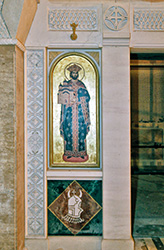 We climbed down the same breakneck path to the basic level and then, following a dark labyrinth stuffed with tools and material, reached the stairs that took us below the Temple, to the church dedicated to prince Lazar, with vault domes currently being painted, and to the crypt intended for Serbian patriarchs.
We climbed down the same breakneck path to the basic level and then, following a dark labyrinth stuffed with tools and material, reached the stairs that took us below the Temple, to the church dedicated to prince Lazar, with vault domes currently being painted, and to the crypt intended for Serbian patriarchs.
Lacy decorative elements from Chilandar are recognized in the stone iconostasis.
– We tried, as much as we could, to respect what we had been assigned, what had been prescribed in the design of Nestorović and Deroko – says Nes. – It was the case with stone as well. We get stone from the same stone pit as they did, we respected 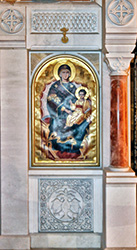 their coloring pattern, the combination of red and green. By the way, to avoid any confusion, the dominant stone in the Temple is the white Tuscany marble from Carrara.
their coloring pattern, the combination of red and green. By the way, to avoid any confusion, the dominant stone in the Temple is the white Tuscany marble from Carrara.
Interesting, the Slovenian company ”Marmor” from Hotavlje is assigned for the stone decoration of the Temple. They do the mechanical rough stone processing. Janez Bizjak, director of the Belgrade branch of this company, has been living in Belgrade for ten years and has already become a local.
– Thanks to him and his people from Hotavlje, but especially thanks to Metropolitan of Zagreb and Ljubljana Porfirije, the exhibition of decorative plastics from the Temple of St. Sava, recently exhibited in the RTS Gallery, will be presented in Ljubljana, most probably in their local Museum of Ethnography – says Nes.
Then he cast a glance somewhere on the side and sighed deeply.
– The works are far from completion. This summer, we have to do the exterior: reliefs on bell towers and the altar apsis are completed, we have three portals with two pillars each, with capitals, portal friezes… Too much work for just one generation.
***
Shaped by Patience
There is a story that late Patriarch German sent out 88 requests to different addresses, asking for permission to continue the construction of the Temple of St. Sava after a break of several decades. Even today, three decades since his last request was granted, no one thinks this is a made up anecdote.
***
From Generations to Generations
As soon as the construction works on the Temple of St. Sava restarted, many impatient ones immediately asked: ”When will it be finished?” Who knows? The Cathedral of St. John the Scholar in New York has been in construction for almost a century and a half, in a country which definitely does not lack money to finish it in six months. The Sagrada Familia Cathedral in Barcelona has been in construction ever since the time of Antonio Gaudi (1852–1926), its famous designer, slowly and methodically, in order to preserve his idea and spirit. The Temple of St. Sava is also not an endowment of only one time and one generation! The hopes of ancestors are woven in it, as it will one day awaken the memories of descendants, warning them to continue where their predecessors have stopped. It is not a race against time.
